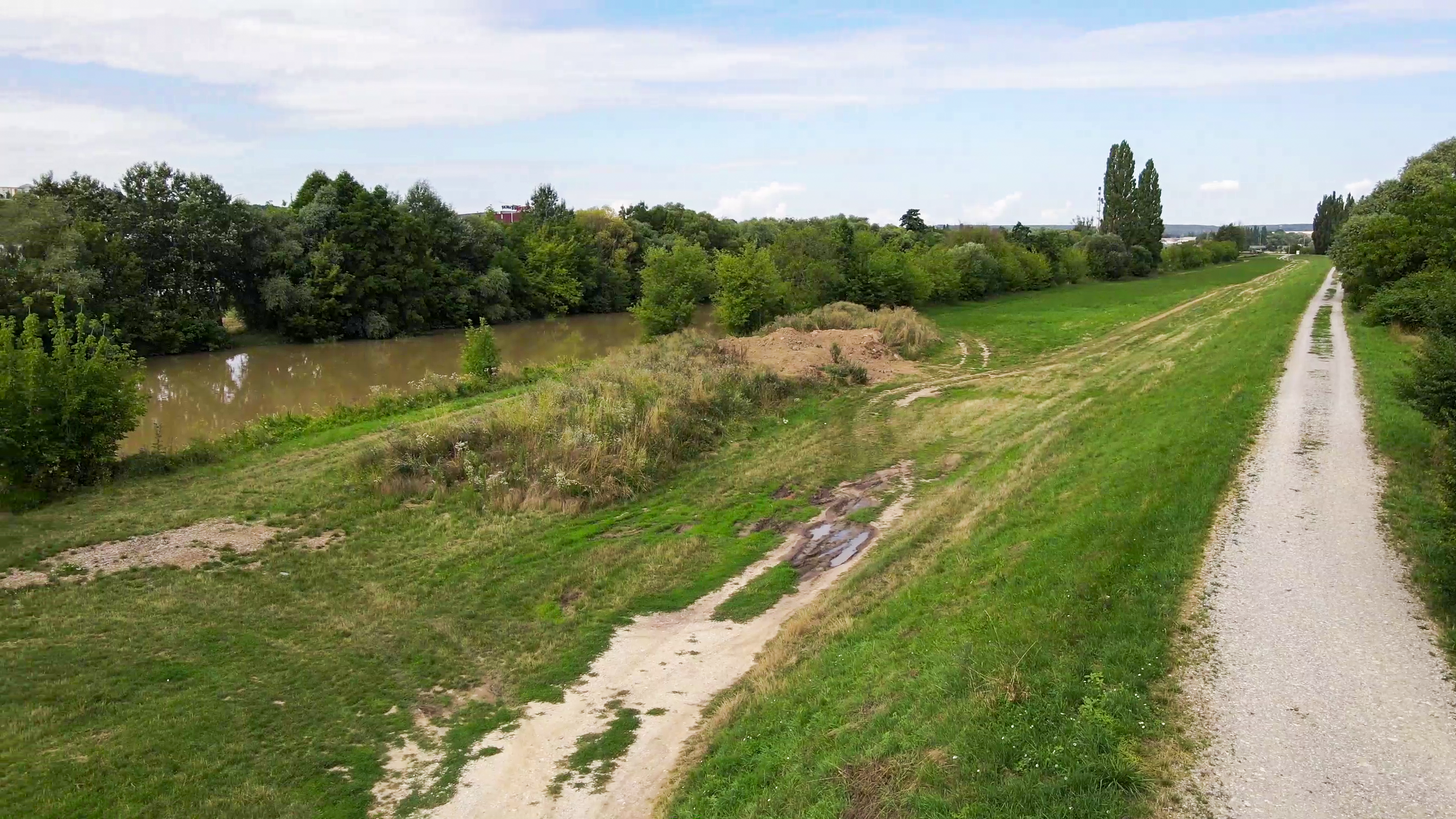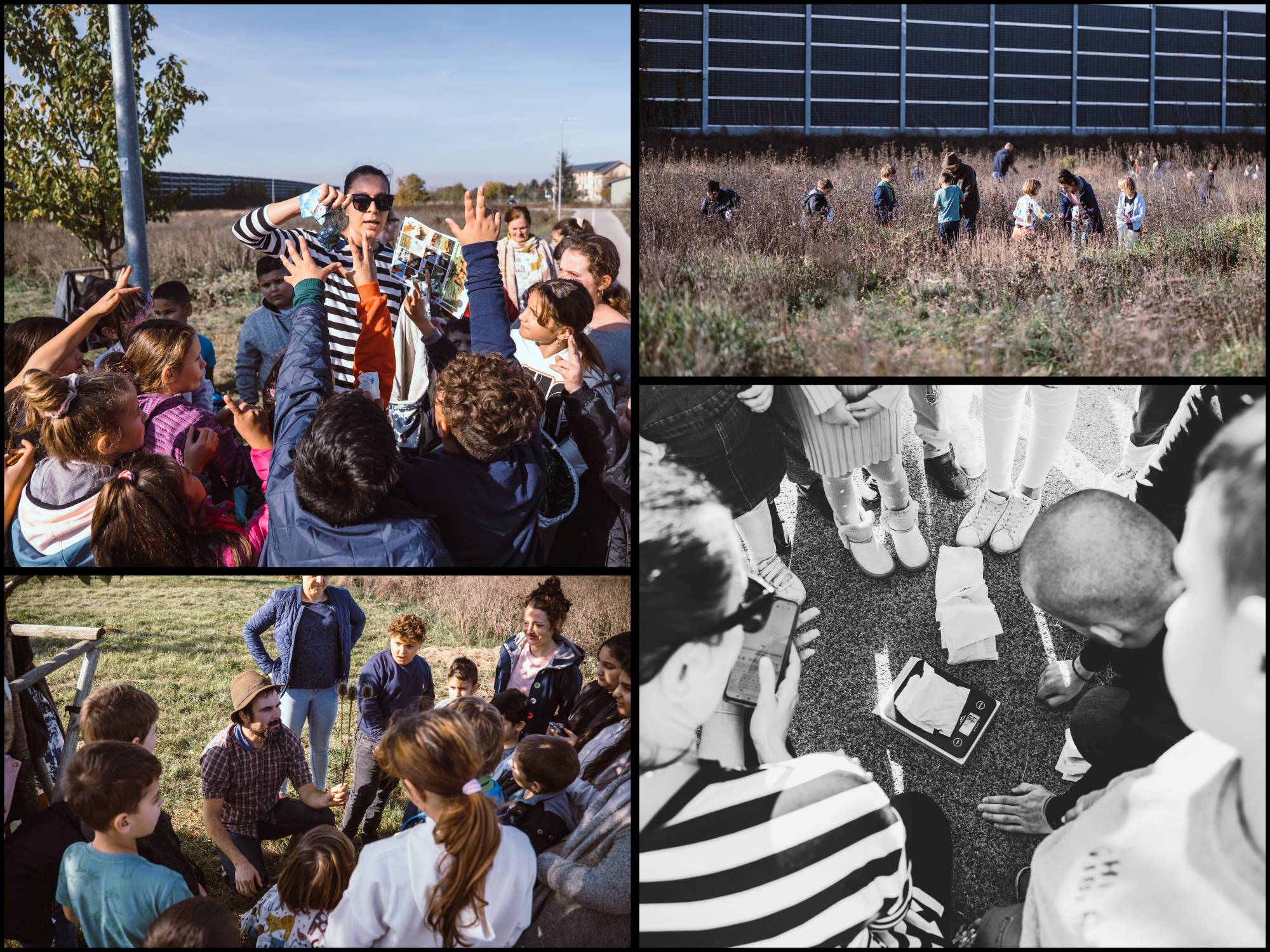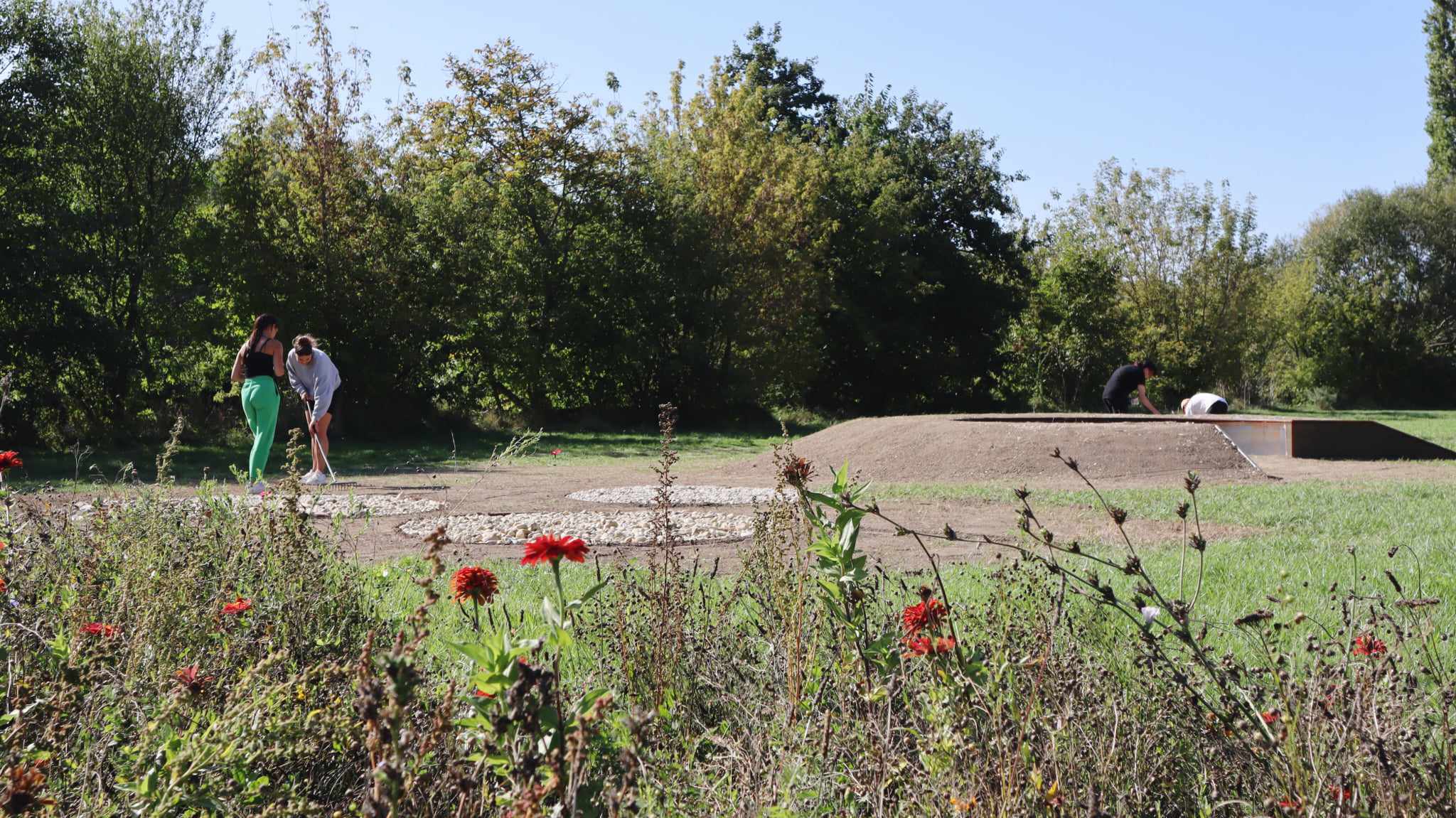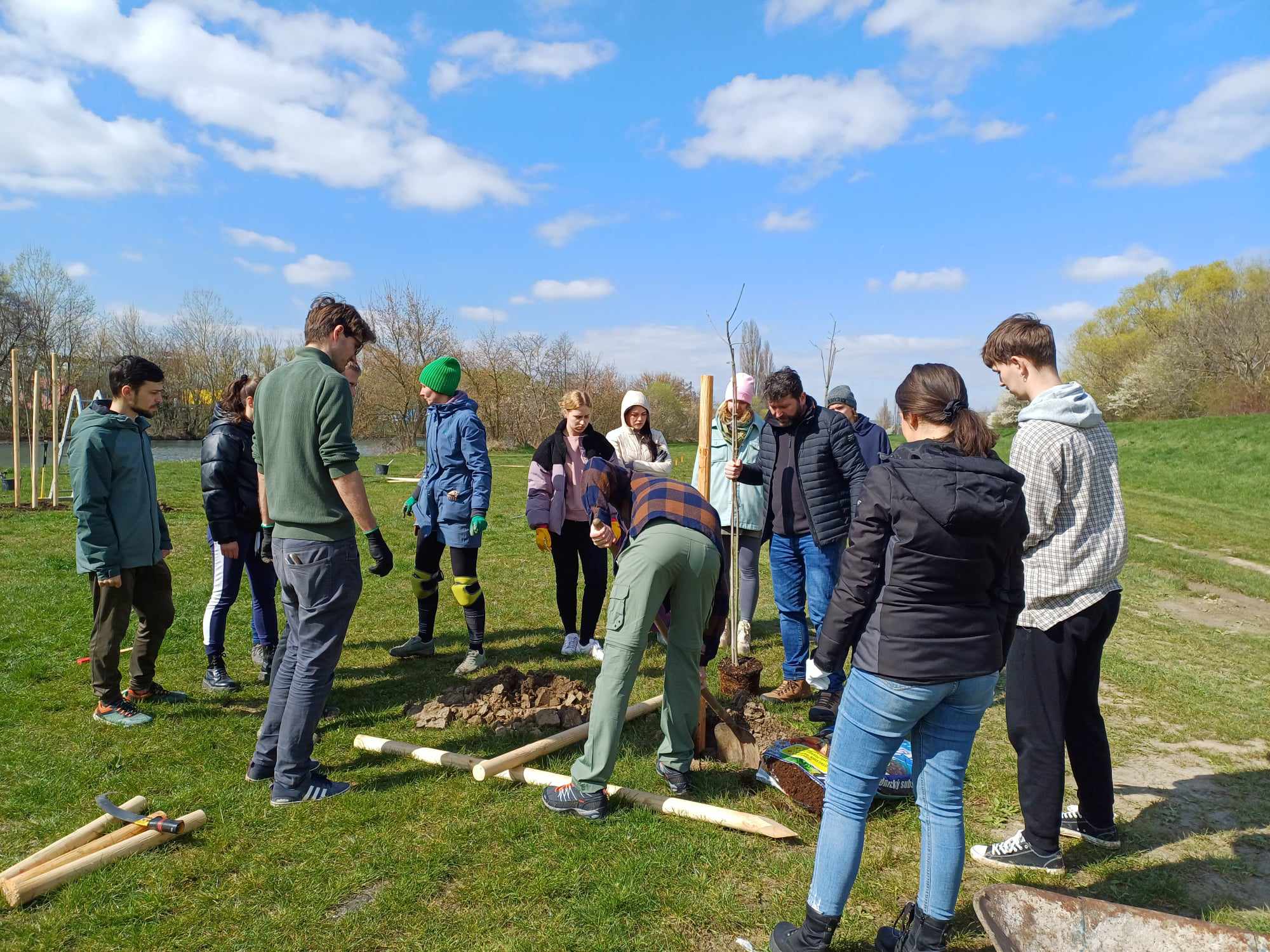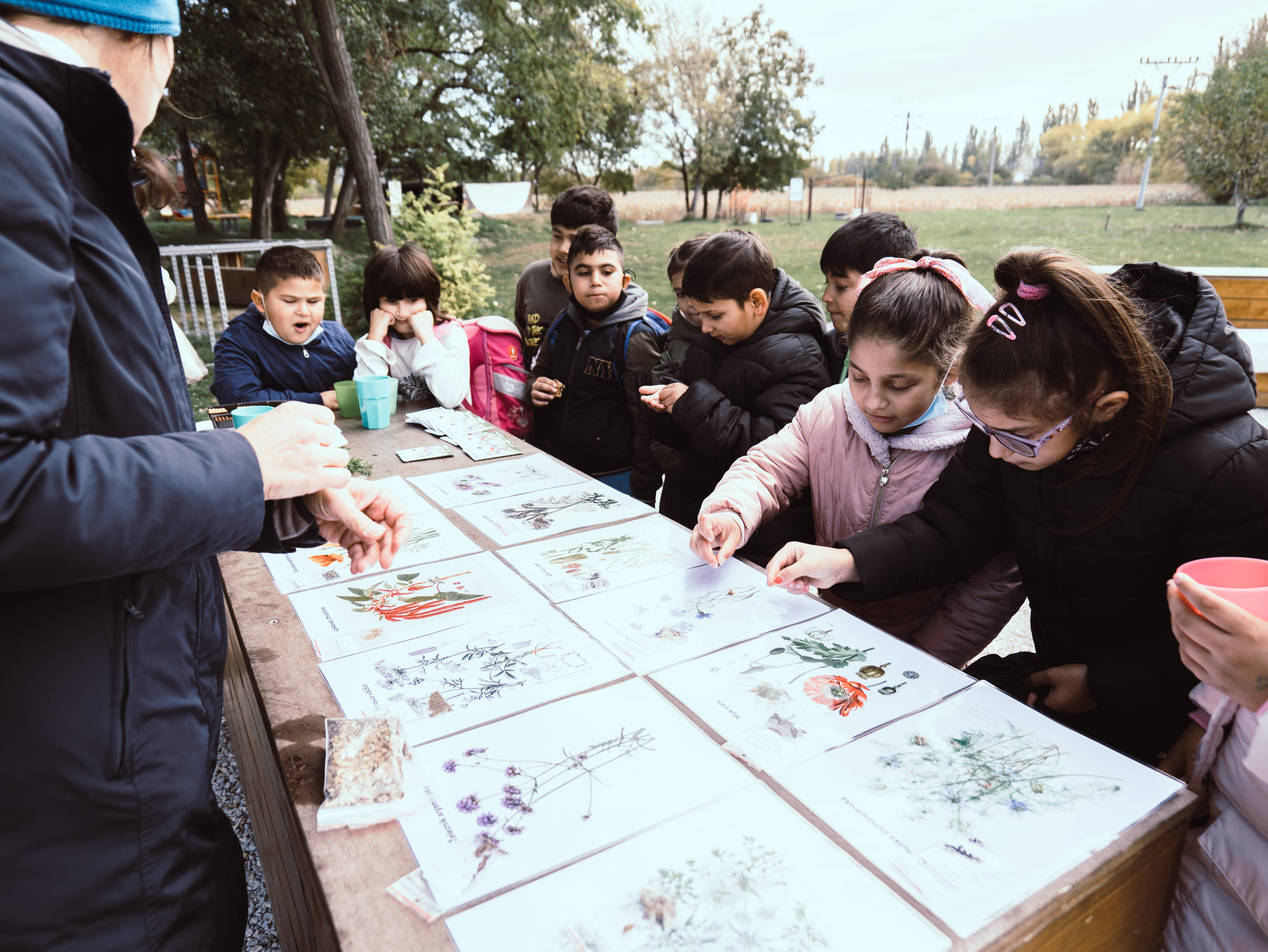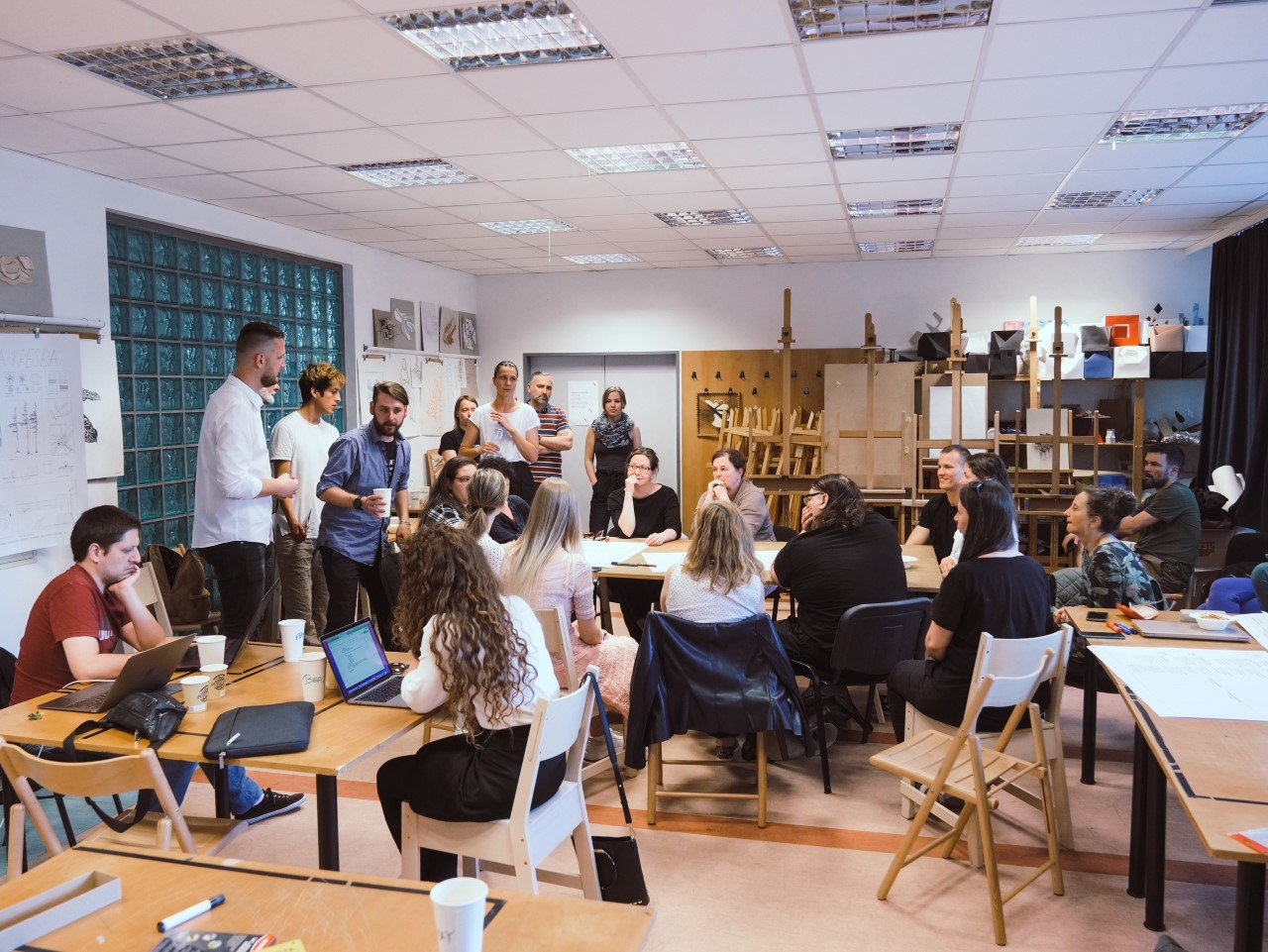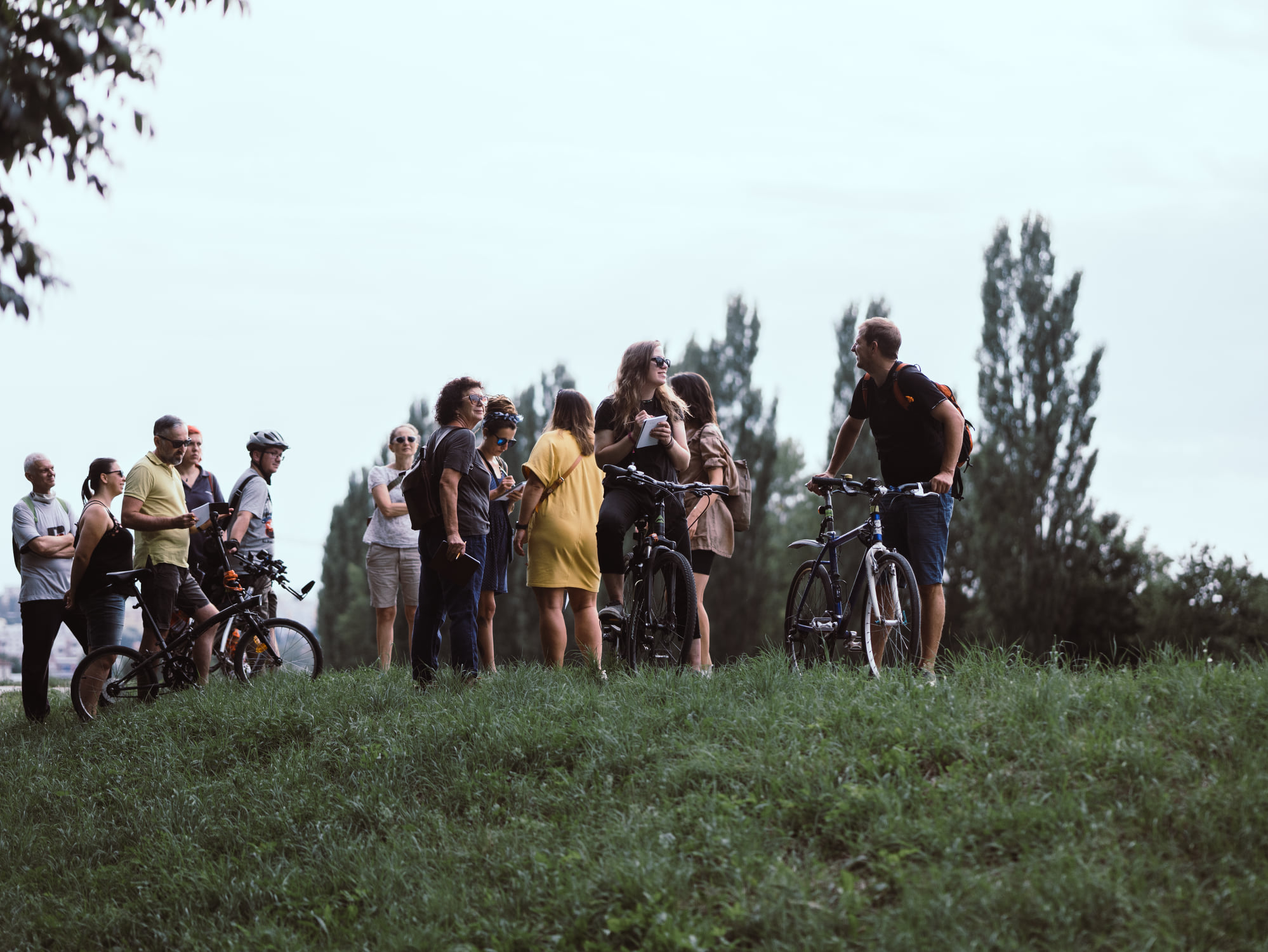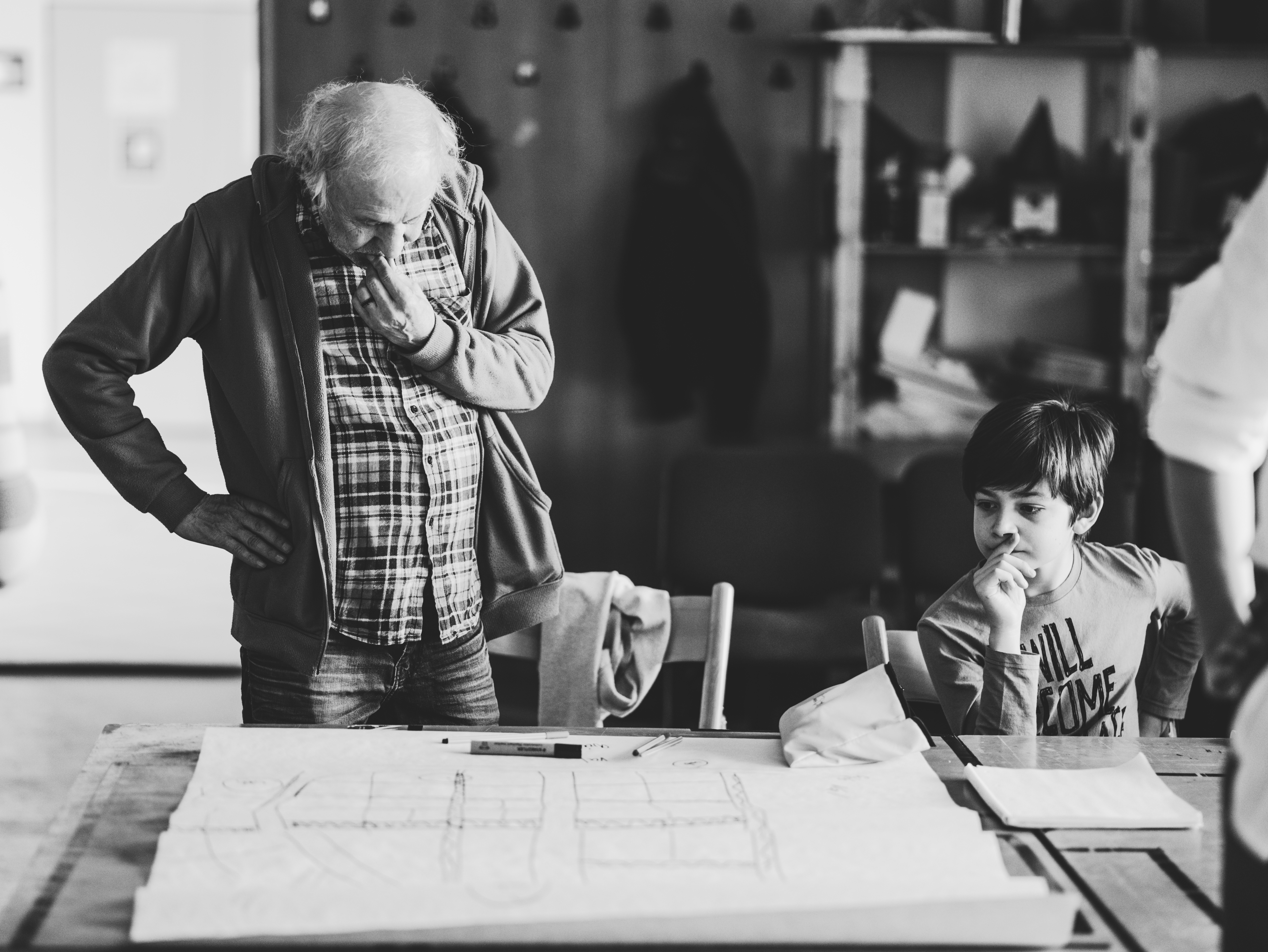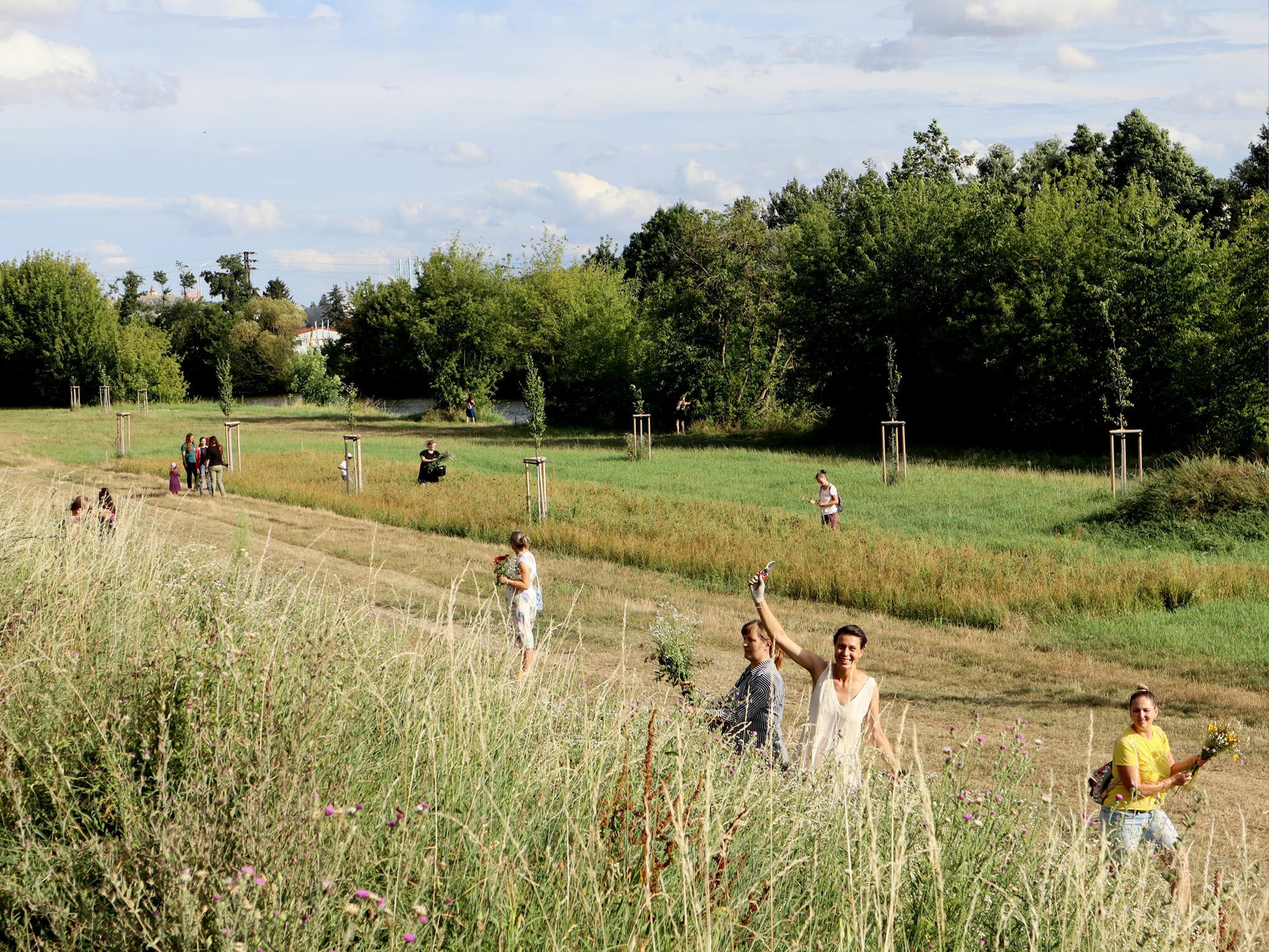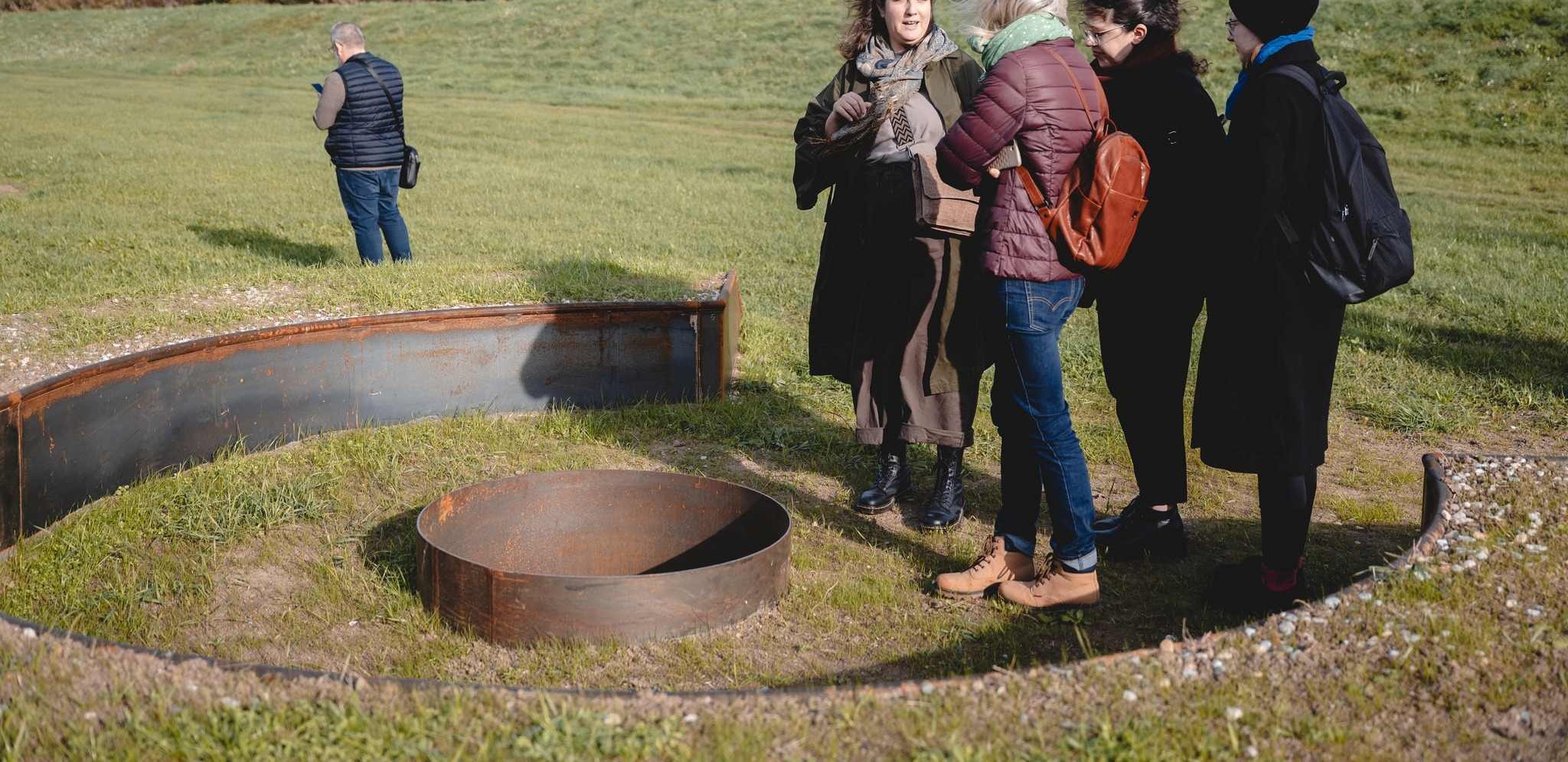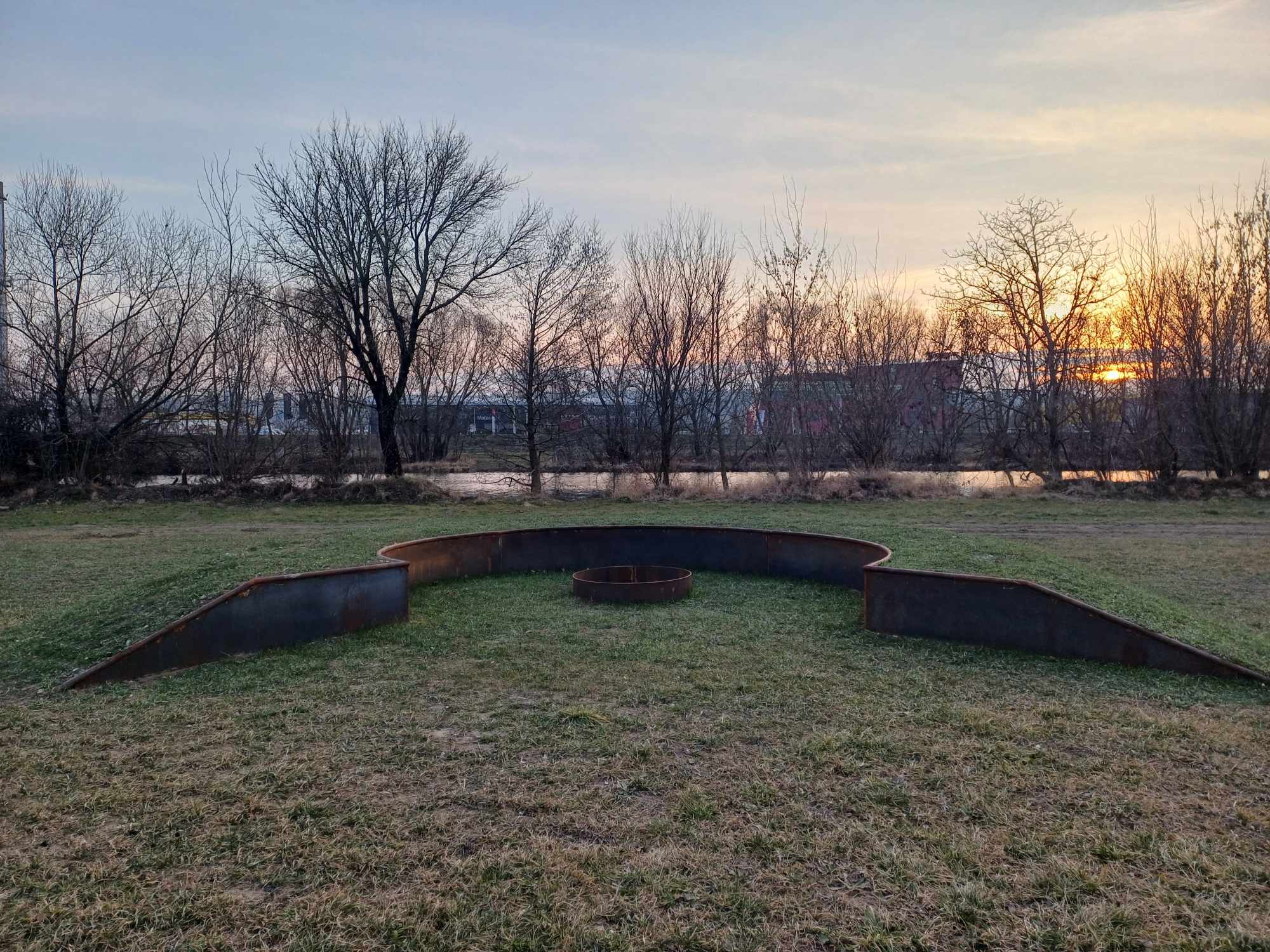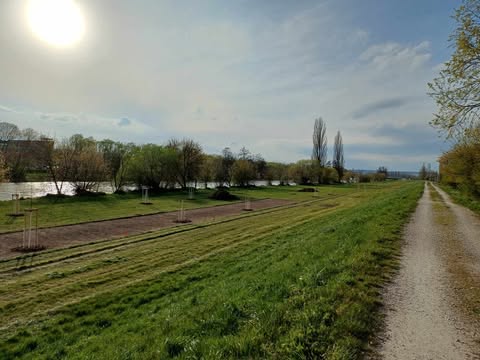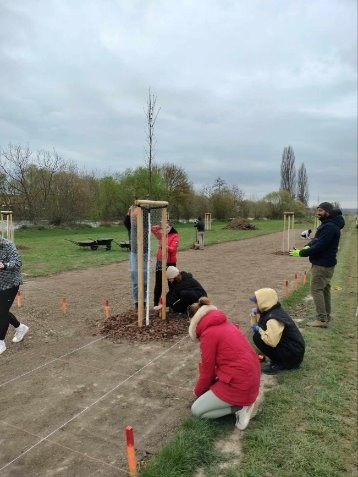Reconnecting with nature
Experimental Floodway Picnic Meadow
Experimental Public Picnic Meadow in the Nitra River Floodway with Innovative Nature-based Solutions
This experimental picnic meadow in Nitra, part of the IN-HABIT project, revitalises a river floodway with native meadows, countersunk grills, an acupressure playground, and terrain modulations. Using a "zero-sum approach," it maintains ecological balance while enhancing biodiversity and public use. Co-created with citizens, students, volunteers, urban planners and other experts it fosters environmental literacy, recreation, and resilience, offering a multifunctional green space for all.
Slovakia
Local
City of Nitra (Nitra region)
Mainly urban
It refers to a physical transformation of the built environment (hard investment)
Yes
2024-08-31
Yes
Horizon2020 / Horizon Europe
No
No
As a representative of an organisation, in partnership with other organisations
The Experimental Public Picnic Meadow in the Nitra River Floodway transforms an underutilized flood-prone urban area into a multifunctional, ecologically sustainable public space. Designed using a zero-sum landscape approach, it preserves floodway integrity while enhancing biodiversity, environmental literacy, and social inclusion. The project targets local residents, students, marginalised groups, and urban planners, promoting community participation and environmental stewardship. Through co-design workshops, citizen science activities, and volunteer engagement, the space has been developed to balance ecological conservation with recreational and educational opportunities. Key objectives include restoring native meadows using participatory phytosociological analyses and traditional land management practices, integrating terrain-modulated seating and countersunk public grills, which are the main innovation, to minimise environmental impact, and foster social inclusion by involving Ukrainian refugees and Roma schoolchildren in the process. The project demonstrates that urban resilience, biodiversity enhancement, and community-driven design can coexist in flood-prone areas without heavy infrastructure. Achieved outcomes include improved urban biodiversity, increased public engagement in sustainable land management, and the development of an innovative, scalable model for integrating nature-based solutions into urban environments. Co-managed by the City of Nitra, academia, and civic organizations, the project ensures long-term sustainability and serves as a best-practice model for similar interventions across Europe, showcasing how nature-based, low-cost solutions can create climate-resilient, socially inclusive, and aesthetically valuable urban spaces.
zero-sum landscape design
citizen science
community co-design
urban biodiversity
floodway adaptation
Picnic Meadow is located in Nitra River floodway. Uniquely challenging due to hydrological conditions (minor changes in water levels can lead to rapid flooding) and strict environmental and regulatory constraints. Traditional urban infrastructure and public space interventions (e.g. playgrounds and benches) are prohibited. Although informally used by fishermen and visitors, the lack of infrastructure and illegal parking near the water posed challenges to creating a functional, sustainable public space.
The rules demand that any intervention must not alter the soil volume, as the balance of material is crucial for its flood-containment properties. The project introduced a solution – a zero-sum approach, where excavated soil is reused to create terrain-modulated seating and play elements, countersunk grills, and wildflower meadows. It aims to preserve, enhance, and adapt the existing ecosystem while making it accessible for public use:
• Test meadow establishment methods with minimal intervention in original ecosystems – Instead of traditional landscaping techniques, local phytosociological analyses ensured that the plant compositions are native, resilient, and contribute to urban biodiversity, serve as pollinator habitats and improve air and soil quality.
• Introduce maintenance methods using traditional land management approaches – Mowing techniques inspired by historical agricultural practices to support water retention in the landscape, regulate natural succession of plant species, and reduce soil degradation.
• Promote community participation in environmental stewardship – volunteers and students planted 41 local tree varieties; BioBlitz events engaged schoolchildren in citizen science activities, raising awareness about urban ecology while collecting environmental data.
Project showcases that flood-prone areas can be transformed into thriving green spaces without heavy infrastructure, demonstrating how climate adaptation and urban recreation can coexist.
The rules demand that any intervention must not alter the soil volume, as the balance of material is crucial for its flood-containment properties. The project introduced a solution – a zero-sum approach, where excavated soil is reused to create terrain-modulated seating and play elements, countersunk grills, and wildflower meadows. It aims to preserve, enhance, and adapt the existing ecosystem while making it accessible for public use:
• Test meadow establishment methods with minimal intervention in original ecosystems – Instead of traditional landscaping techniques, local phytosociological analyses ensured that the plant compositions are native, resilient, and contribute to urban biodiversity, serve as pollinator habitats and improve air and soil quality.
• Introduce maintenance methods using traditional land management approaches – Mowing techniques inspired by historical agricultural practices to support water retention in the landscape, regulate natural succession of plant species, and reduce soil degradation.
• Promote community participation in environmental stewardship – volunteers and students planted 41 local tree varieties; BioBlitz events engaged schoolchildren in citizen science activities, raising awareness about urban ecology while collecting environmental data.
Project showcases that flood-prone areas can be transformed into thriving green spaces without heavy infrastructure, demonstrating how climate adaptation and urban recreation can coexist.
Picnic Meadow redefines public space aesthetics by harmonising urban design with natural landscapes. Unlike conventional parks with traditional infrastructure, we utilised terrain modelling to create a seamless, organic aesthetic that blends into the riverbank. The intervention enhances both visual and sensory quality by integrating functional and artistic landscape features that complement the natural environment characterised by very strict design limitations through:
• Innovative non-intrusive design to ensure spatial coherence – newly introduced elements (terrain-modulation playground, acupressure playground and countersunk grills) were designed to adapt to existing topography, preserving visual and spatial harmony. Acupressure playground, composed of different natural stone textures, introduces a tactile and visual contrast, offering a multisensory engagement with nature.
• Three distinct wildflower meadows designed with unique seasonal floral compositions, ensuring dynamic year-round aesthetic appeal. By planting 41 trees, including native fruit varieties, we aimed to restore local natural heritage.
• The key design innovation – public grills created with terrain modelling and countersunk in the riverbed terrace – serve as social hubs for relaxation and interaction while respecting the site's natural integrity. Structural parts of the countersunk grills are made of Corten (weathering) steel resistant to corrosion due to protective rust-like patina, eliminating the need for painting and maintenance. Drainage layers aid in water infiltration after flooding. This design ensures long-term resilience while also adhering to strict safety regulations required for flood-prone areas.
This intervention exemplifies how urban aesthetics can emerge from context-sensitive, biophilic design and does not require artificial embellishments. It also shows how design innovation can transform building restrictions into opportunities for functional and sustainable solutions.
• Innovative non-intrusive design to ensure spatial coherence – newly introduced elements (terrain-modulation playground, acupressure playground and countersunk grills) were designed to adapt to existing topography, preserving visual and spatial harmony. Acupressure playground, composed of different natural stone textures, introduces a tactile and visual contrast, offering a multisensory engagement with nature.
• Three distinct wildflower meadows designed with unique seasonal floral compositions, ensuring dynamic year-round aesthetic appeal. By planting 41 trees, including native fruit varieties, we aimed to restore local natural heritage.
• The key design innovation – public grills created with terrain modelling and countersunk in the riverbed terrace – serve as social hubs for relaxation and interaction while respecting the site's natural integrity. Structural parts of the countersunk grills are made of Corten (weathering) steel resistant to corrosion due to protective rust-like patina, eliminating the need for painting and maintenance. Drainage layers aid in water infiltration after flooding. This design ensures long-term resilience while also adhering to strict safety regulations required for flood-prone areas.
This intervention exemplifies how urban aesthetics can emerge from context-sensitive, biophilic design and does not require artificial embellishments. It also shows how design innovation can transform building restrictions into opportunities for functional and sustainable solutions.
With Picnic Meadow, we aimed to create an inclusive, accessible and community-driven green public space. During the planning phase, the co-design of the interventions included over 20 stakeholder meetings and one-on-one consultations with community groups, urban planners, landscape architects, and civic organisations. Through transect walks, discussions, and workshops, users co-defined the space, ensuring it meets diverse needs while fostering a strong sense of belonging.
During volunteer-driven co-deployment, where students, researchers, and residents, including marginalised groups such as Ukrainian refugees who frequent nearby areas, participated in site interventions. Nearby Hidepark (outdoor grassroots community and cultural centre created by revitalising a landfill) helped with the engagement of volunteers in meadow and tree planting and landscape maintenance, fostering a sense of shared responsibility and active citizenship.
The compositions of meadows were based on phytosociological analysis that was conducted through BioBlitz citizen science events where 38 schoolchildren from vulnerable backgrounds (almost completely segregated so-called “Roma school” from nearby residential neighbourhood), together with 5 teachers and 3 researchers collected data along the inundation zone. These activities not only enhanced environmental awareness but also provided early STEM exposure to groups with limited access to such opportunities.
Community governance was embedded through a co-management framework by the City of Nitra, other public authorities and the private and civic sectors that play an active role in the maintenance and ongoing enhancement of the site (e.g. boosting engagement with creative workshops in partnership with local florists on bouquet and wreath design from meadow flowers and other material available on-site, maintenance doubled as educational activities for citizens and students on landscape management, professional tree pruning techniques etc.).
During volunteer-driven co-deployment, where students, researchers, and residents, including marginalised groups such as Ukrainian refugees who frequent nearby areas, participated in site interventions. Nearby Hidepark (outdoor grassroots community and cultural centre created by revitalising a landfill) helped with the engagement of volunteers in meadow and tree planting and landscape maintenance, fostering a sense of shared responsibility and active citizenship.
The compositions of meadows were based on phytosociological analysis that was conducted through BioBlitz citizen science events where 38 schoolchildren from vulnerable backgrounds (almost completely segregated so-called “Roma school” from nearby residential neighbourhood), together with 5 teachers and 3 researchers collected data along the inundation zone. These activities not only enhanced environmental awareness but also provided early STEM exposure to groups with limited access to such opportunities.
Community governance was embedded through a co-management framework by the City of Nitra, other public authorities and the private and civic sectors that play an active role in the maintenance and ongoing enhancement of the site (e.g. boosting engagement with creative workshops in partnership with local florists on bouquet and wreath design from meadow flowers and other material available on-site, maintenance doubled as educational activities for citizens and students on landscape management, professional tree pruning techniques etc.).
Diverse community groups, urban planners and experts from relevant fields, city employees, landscape architects, and civic organisations representing specific user profiles (e.g. civic association Lets Cycle Nitra! representing cyclists using the adjacent bike path; civic association Cuketa operating a nearby community garden; ZAN – association of architects in Nitra) met, discussed challenges of the space and voiced their needs, ensuring that the final design reflected local expectations while meeting environmental and regulatory constraints.
Citizens, volunteers and landscape architecture, horticulture and landscape engineering students were involved in implementation. Students received credits as part of practical internships with subcontractors, implementing the hard solutions and developed new skills. Volunteers and citizens, along with skill development, enhanced their community engagement and acquired a sense of ownership of the co-created space. To encourage sustained participation, Hidepark partner provided benefits such as community bike-sharing access and free cultural events entry. Employees of two major companies were involved through their employee volunteering programs in replanting trees along the bike path leading to the meadow. Two Ukrainian refugees were directly employed by the project.
We monitor the impact through questionnaires and interviews. Local policy representative stated: “It was a scientific project most interconnected with real city life, especially evident in public spaces, community life, and integration activities. We see those unused spaces suddenly filled with life. The community also educated itself through the connections made with young people, experts, and architects. Student/volunteer stated: “Involved participants in the workshops could be engaged from planning through to implementation, which is highly valuable to develop in post-communist countries where people are not accustomed to being asked for their opinion.”
Citizens, volunteers and landscape architecture, horticulture and landscape engineering students were involved in implementation. Students received credits as part of practical internships with subcontractors, implementing the hard solutions and developed new skills. Volunteers and citizens, along with skill development, enhanced their community engagement and acquired a sense of ownership of the co-created space. To encourage sustained participation, Hidepark partner provided benefits such as community bike-sharing access and free cultural events entry. Employees of two major companies were involved through their employee volunteering programs in replanting trees along the bike path leading to the meadow. Two Ukrainian refugees were directly employed by the project.
We monitor the impact through questionnaires and interviews. Local policy representative stated: “It was a scientific project most interconnected with real city life, especially evident in public spaces, community life, and integration activities. We see those unused spaces suddenly filled with life. The community also educated itself through the connections made with young people, experts, and architects. Student/volunteer stated: “Involved participants in the workshops could be engaged from planning through to implementation, which is highly valuable to develop in post-communist countries where people are not accustomed to being asked for their opinion.”
Implemented within the IN-HABIT (Horizon 2020), the Picnic Meadow was envisioned with both vertical and horizontal stakeholder integration from the start.
Vertical integration was initiated on the European level. IN-HABIT partners (e.g. Tesserae – focused on grassroots policy design; isIMPACT – focused on inclusive social impact assessment; Design for Change – introducing mindset change methodologies) trained local community activators working on the project in co-creation methodologies. On the national level, Slovak Waterways Company (public authority under Ministry of Environment), as landowners, were deeply involved in co-designing and later co-managing the site, allowing the project to navigate strict floodway regulations.
On local level, the Slovak University of Agriculture (Institute of Landscape Architecture, Institute of Sustainable Regional and Local Development and AgroBioTech – research transfer centre) partnered with the City of Nitra and Hidepark (NGO) in all phases of the project. The university provided technical expertise and funded the hard interventions. Hidepark facilitated volunteer engagement, awareness campaigns, maintenance activities, tree planting and event organisation. The city assisted with permitting, urban planning integration, and coordination with higher-level authorities. Its involvement ensured the project aligned with broader urban development goals; it will also co-manage the project results in the future. The added value was:
• Regulatory innovation – public authorities enabled testing of new permitting processes for flood-prone areas.
• Technical expertise – academic partners ensured that the project was scientifically grounded while monitoring the impacts.
• By involving civic stakeholders, we ensured public buy-in and continued use beyond the initial phase.
• Scalability/replication – European-level engagement allowed the project to serve as a model for similar nature-based interventions across other flood-prone areas.
Vertical integration was initiated on the European level. IN-HABIT partners (e.g. Tesserae – focused on grassroots policy design; isIMPACT – focused on inclusive social impact assessment; Design for Change – introducing mindset change methodologies) trained local community activators working on the project in co-creation methodologies. On the national level, Slovak Waterways Company (public authority under Ministry of Environment), as landowners, were deeply involved in co-designing and later co-managing the site, allowing the project to navigate strict floodway regulations.
On local level, the Slovak University of Agriculture (Institute of Landscape Architecture, Institute of Sustainable Regional and Local Development and AgroBioTech – research transfer centre) partnered with the City of Nitra and Hidepark (NGO) in all phases of the project. The university provided technical expertise and funded the hard interventions. Hidepark facilitated volunteer engagement, awareness campaigns, maintenance activities, tree planting and event organisation. The city assisted with permitting, urban planning integration, and coordination with higher-level authorities. Its involvement ensured the project aligned with broader urban development goals; it will also co-manage the project results in the future. The added value was:
• Regulatory innovation – public authorities enabled testing of new permitting processes for flood-prone areas.
• Technical expertise – academic partners ensured that the project was scientifically grounded while monitoring the impacts.
• By involving civic stakeholders, we ensured public buy-in and continued use beyond the initial phase.
• Scalability/replication – European-level engagement allowed the project to serve as a model for similar nature-based interventions across other flood-prone areas.
Various project stages required participation from multiple experts across different fields, including designers, landscape architects, biochemists, methodologists, community activators, specialists in ecological and historic landscape restoration, meadow composition experts, dendrologists, special education experts, engineers, hydrotechnicians, and lawyers. In the design process, the spatial-compositional was created by a designer, including specific recreational features, drawing from outputs of participatory activities with the public, students, and experts. These activities were co-developed by the project's methodologist (social sciences) and designer, along with the community activator. Biochemists, meadow composition experts, and specialists in ecological and historical restoration participated in selecting the assortment of meadow mixes that support soil fertility, biodiversity, and drought resistance. They also prepared a maintenance manual. Along with the community activator, an alternative education expert, and the designer, they prepared and implemented educational and promotional activities for children and the public. The overall quality of the project was monitored and approved by the landscape architect.
Dendrologists provided expert assessment and selection of trees. Also, along with the community activator and alternative education expert, conducted educational activities about tree species, their planting, and maintenance. The implementation was planned and led by the designer, subcontractors, biotechnician, methodologist, and community activator. The engineer and hydrotechnician monitored the safety and quality of the solutions. The lawyer focused on legal aspects such as securing permits, complying with regulations, and protecting public and private interests.
This interdisciplinary approach created added value in the form of comprehensive, ecologically sustainable, aesthetically pleasing, and community-accepted solutions.
Dendrologists provided expert assessment and selection of trees. Also, along with the community activator and alternative education expert, conducted educational activities about tree species, their planting, and maintenance. The implementation was planned and led by the designer, subcontractors, biotechnician, methodologist, and community activator. The engineer and hydrotechnician monitored the safety and quality of the solutions. The lawyer focused on legal aspects such as securing permits, complying with regulations, and protecting public and private interests.
This interdisciplinary approach created added value in the form of comprehensive, ecologically sustainable, aesthetically pleasing, and community-accepted solutions.
The Picnic Meadow in Nitra is truly experimental, particularly in its co-co-co approach and approach to flood-prone areas. Here, we would like to highlight:
1. Zero-Sum approach in landscape design: most urban projects in flood-prone areas limit or entirely avoid structural changes due to the risk of exacerbating flood conditions. The project employs a creative approach where soil excavated for one purpose is reused within the project to ensure no net gain or loss in soil volume. This maintains the floodway's functionality while allowing for ecological enhancements and public use.
2. Integration with the natural landscape: instead of imposing conventional urban structures, the project moulds the landscape to fit both ecological and recreational needs. This includes terrain-modulated seating, countersunk grills, and diverse native meadow plantings, which serve functional purposes while preserving and enhancing the area's natural aesthetics. We tried to show how urban design can be both beautiful and practical without the extensive use of artificial materials, which is a significant shift from typical urban park designs in Slovak context.
3. Community and volunteer involvement: the project is co-created with local communities, including students and volunteers. This collaborative process not only fosters community ties and environmental stewardship but also educates participants on sustainable practices and local biodiversity.
4. Sustainable maintenance practices: drawing on traditional land management techniques, we use mowing strategies and plant selections that contribute to soil health, water retention, and biodiversity. These practices showcase low-impact maintenance for urban green spaces.
5. Educational and inclusive outreach: BioBlitz events and other educational programs that engage local schools and community groups, including marginalized populations. These initiatives are crucial for raising ecological awareness in an interactive, real-world context.
1. Zero-Sum approach in landscape design: most urban projects in flood-prone areas limit or entirely avoid structural changes due to the risk of exacerbating flood conditions. The project employs a creative approach where soil excavated for one purpose is reused within the project to ensure no net gain or loss in soil volume. This maintains the floodway's functionality while allowing for ecological enhancements and public use.
2. Integration with the natural landscape: instead of imposing conventional urban structures, the project moulds the landscape to fit both ecological and recreational needs. This includes terrain-modulated seating, countersunk grills, and diverse native meadow plantings, which serve functional purposes while preserving and enhancing the area's natural aesthetics. We tried to show how urban design can be both beautiful and practical without the extensive use of artificial materials, which is a significant shift from typical urban park designs in Slovak context.
3. Community and volunteer involvement: the project is co-created with local communities, including students and volunteers. This collaborative process not only fosters community ties and environmental stewardship but also educates participants on sustainable practices and local biodiversity.
4. Sustainable maintenance practices: drawing on traditional land management techniques, we use mowing strategies and plant selections that contribute to soil health, water retention, and biodiversity. These practices showcase low-impact maintenance for urban green spaces.
5. Educational and inclusive outreach: BioBlitz events and other educational programs that engage local schools and community groups, including marginalized populations. These initiatives are crucial for raising ecological awareness in an interactive, real-world context.
The methodology implemented in this intervention was developed within a broader CO-CO-CO-CO approach of the IN-HABIT project. It is a PARTICIPATORY DESIGN approach comprising four key elements:
CO-DESIGN: stakeholders collaboratively design interventions, ensuring diverse input and ideas reflect community needs.
CO-DEPLOYMENT: implemented with active participation from stakeholders, maintaining the integrity of the original ideas.
CO-MANAGEMENT: maintenance of the intervention involves all stakeholders, fostering sustained engagement and adaptive practices.
CO-ASSESSMENT: impact is evaluated collaboratively, gathering feedback to understand efficacy and reception, and to adjust future practices.
For this specific intervention, a COLLABORATIVE PLANNING approach was applied at the level of cooperation between the city government of Nitra, the Slovak University of Agriculture, the civic association Hidepark, and the Slovak Waterways Management Company. At the expertise dimension, the TRANSDISCIPLINARY DESIGN process was led by a designer, social sciences methodologist, and community activator, but also included experts in landscape architecture and planning, biochemists, specialists in ecological and historic landscape restoration, experts in meadow compositions, etc. During commented TRANSECT WALKS, CO-DESIGN WORKSHOPS, PARTICIPATORY PHYTOSOCIOLOGICAL ANALYSES, and educational and volunteer activities, they formed an important structural part of the project. All stages of the CO-CO-CO-CO involved many communities: students, excluded communities (Roma, Ukrainian, Serbian), users of the site (cyclists, gardeners, fishermen, community garden and Hidepark visitors, and the public of the city of Nitra). The design process integrated principles of BIOPHILIC URBANISM, with specific adaptation to floodways to transform them into functional recreational public green spaces without compromising on safety, environmental stability and access for different populations.
CO-DESIGN: stakeholders collaboratively design interventions, ensuring diverse input and ideas reflect community needs.
CO-DEPLOYMENT: implemented with active participation from stakeholders, maintaining the integrity of the original ideas.
CO-MANAGEMENT: maintenance of the intervention involves all stakeholders, fostering sustained engagement and adaptive practices.
CO-ASSESSMENT: impact is evaluated collaboratively, gathering feedback to understand efficacy and reception, and to adjust future practices.
For this specific intervention, a COLLABORATIVE PLANNING approach was applied at the level of cooperation between the city government of Nitra, the Slovak University of Agriculture, the civic association Hidepark, and the Slovak Waterways Management Company. At the expertise dimension, the TRANSDISCIPLINARY DESIGN process was led by a designer, social sciences methodologist, and community activator, but also included experts in landscape architecture and planning, biochemists, specialists in ecological and historic landscape restoration, experts in meadow compositions, etc. During commented TRANSECT WALKS, CO-DESIGN WORKSHOPS, PARTICIPATORY PHYTOSOCIOLOGICAL ANALYSES, and educational and volunteer activities, they formed an important structural part of the project. All stages of the CO-CO-CO-CO involved many communities: students, excluded communities (Roma, Ukrainian, Serbian), users of the site (cyclists, gardeners, fishermen, community garden and Hidepark visitors, and the public of the city of Nitra). The design process integrated principles of BIOPHILIC URBANISM, with specific adaptation to floodways to transform them into functional recreational public green spaces without compromising on safety, environmental stability and access for different populations.
This approach can be replicated in different socio-ecological contexts, particularly in cities looking to increase public access to nature while balancing conservation and recreation. The most replicable elements are:
1. CO-CO-CO-CO approach: participatory co-design, co-deployment, co-management, and co-assessment model ensures that the project is inclusive, adaptable, and sustainable. This methodology can be applied to other public space interventions to engage local communities effectively. The involvement of municipalities, universities, civic associations, and landowners in decision-making can be replicated in other urban or peri-urban projects. The project engaged students, residents, and marginalised groups. This model could be adapted to other social inclusion and community-building initiatives
2. Zero-Sum landscape design: the project's strategy of reusing excavated soil to maintain the floodway’s ecological balance while enhancing its usability can be applied to other flood-prone areas. Non-intrusive design elements, terrain-modulated seating, and countersunk public grills can inspire other projects that seek minimalist, eco-sensitive public space designs. The design drawings and technical documentation are made freely available for replication and adaptation to different topographical conditions (specific technological solutions are easily adaptable e.g. to different levels of ground-water present)
3. Citizen science & educational activities: the BioBlitz model, where schoolchildren and community members participate in environmental data collection in phytosociological analyses for selecting native, resilient plant species, can be used in schools, parks, and conservation projects to promote ecological literacy
4. Traditional land management for sustainable maintenance: the project incorporates historical mowing techniques to regulate soil quality, biodiversity, and water retention, which can be adapted in other urban green spaces
1. CO-CO-CO-CO approach: participatory co-design, co-deployment, co-management, and co-assessment model ensures that the project is inclusive, adaptable, and sustainable. This methodology can be applied to other public space interventions to engage local communities effectively. The involvement of municipalities, universities, civic associations, and landowners in decision-making can be replicated in other urban or peri-urban projects. The project engaged students, residents, and marginalised groups. This model could be adapted to other social inclusion and community-building initiatives
2. Zero-Sum landscape design: the project's strategy of reusing excavated soil to maintain the floodway’s ecological balance while enhancing its usability can be applied to other flood-prone areas. Non-intrusive design elements, terrain-modulated seating, and countersunk public grills can inspire other projects that seek minimalist, eco-sensitive public space designs. The design drawings and technical documentation are made freely available for replication and adaptation to different topographical conditions (specific technological solutions are easily adaptable e.g. to different levels of ground-water present)
3. Citizen science & educational activities: the BioBlitz model, where schoolchildren and community members participate in environmental data collection in phytosociological analyses for selecting native, resilient plant species, can be used in schools, parks, and conservation projects to promote ecological literacy
4. Traditional land management for sustainable maintenance: the project incorporates historical mowing techniques to regulate soil quality, biodiversity, and water retention, which can be adapted in other urban green spaces
The Experimental Floodway Picnic Meadow in Nitra tackles global challenges like climate adaptation, biodiversity loss, and social inclusion through local, nature-based solutions. Using a zero-sum approach, it transforms a flood-prone area into a climate-resilient green space while preserving soil balance. Native meadows enhance biodiversity, traditional mowing techniques support soil and water retention, and sustainable design integrates terrain-modulated seating and countersunk grills. The project fosters social equity by engaging Ukrainian refugees, Roma schoolchildren, and local volunteers in co-creation, environmental education, and community governance. A co-management framework between the City of Nitra, NGOs, and academia ensures long-term sustainability. Through citizen science, BioBlitz events, and low-maintenance infrastructure, the project serves as a scalable model for flood-adaptive, inclusive urban spaces.
However, the most exemplary achievement we want to showcase is that the co-design, co-deployment and co-management approach to Picnic Meadow disproved the relatively common notion that participation and inclusion of different, especially marginalised stakeholders in the process of planning and implementation of public space interventions is more costly. The hard interventions were implemented through a public procurement process. During the implementation, the private subcontractors provided lectures and practical workshops for volunteers, citizens and landscape architecture, horticulture and landscape engineering students. Involved received credits, developed their skills, and enhanced community engagement and ownership over the project while we managed to reduce the initial budget by more than half (from more than 200 thousand € to 80 thousand €). This example shows that accessible, community-driven and socially equitable public space does not have to cost more than the traditional approaches still preferred by many public authorities.
However, the most exemplary achievement we want to showcase is that the co-design, co-deployment and co-management approach to Picnic Meadow disproved the relatively common notion that participation and inclusion of different, especially marginalised stakeholders in the process of planning and implementation of public space interventions is more costly. The hard interventions were implemented through a public procurement process. During the implementation, the private subcontractors provided lectures and practical workshops for volunteers, citizens and landscape architecture, horticulture and landscape engineering students. Involved received credits, developed their skills, and enhanced community engagement and ownership over the project while we managed to reduce the initial budget by more than half (from more than 200 thousand € to 80 thousand €). This example shows that accessible, community-driven and socially equitable public space does not have to cost more than the traditional approaches still preferred by many public authorities.
We believe we achieved significant results, outcomes, and impacts in relation to the "Reconnecting with Nature" category by successfully integrating urban resilience, biodiversity restoration, and social inclusion into a flood-prone public space.
Results & outcomes:
• Climate adaptation & biodiversity enhancement: By transforming a floodway into a thriving natural meadow, the project mitigates flood risks while increasing urban biodiversity. The use of native meadow species, based on phytosociological analysis, has improved soil health, water retention, and pollinator habitats.
• Sustainable & low-impact urban design: The zero-sum landscape approach ensures no net soil displacement, balancing flood management with recreational needs. Innovative features like terrain-modulated seating, countersunk grills, and acupressure playgrounds harmonize with nature without disturbing the ecological balance.
Impacts on direct & indirect beneficiaries
• Community engagement & environmental education: Over 20 stakeholder meetings, co-design workshops, and volunteer-driven co-deployment sessions engaged diverse institutional and individual stakeholders fostering environmental stewardship and active participation.
• Inclusivity & social integration: The project directly involved Ukrainian refugees, Roma schoolchildren, and local volunteers, providing hands-on experience in ecological restoration and citizen science activities. 50 stakeholders were interviewed to measure the impact of the intervention, and they overwhelmingly report positive experiences and increase in site visitation. To aid in future impact assessment, we plan to install people counting sensors to collect more specific data on community engagement.
• Governance & policy innovation: A co-management framework between the City of Nitra, NGOs, academia, and public authorities ensures the long-term sustainability of the project. The initiative serves as a pilot model for flood-prone urban areas.
Results & outcomes:
• Climate adaptation & biodiversity enhancement: By transforming a floodway into a thriving natural meadow, the project mitigates flood risks while increasing urban biodiversity. The use of native meadow species, based on phytosociological analysis, has improved soil health, water retention, and pollinator habitats.
• Sustainable & low-impact urban design: The zero-sum landscape approach ensures no net soil displacement, balancing flood management with recreational needs. Innovative features like terrain-modulated seating, countersunk grills, and acupressure playgrounds harmonize with nature without disturbing the ecological balance.
Impacts on direct & indirect beneficiaries
• Community engagement & environmental education: Over 20 stakeholder meetings, co-design workshops, and volunteer-driven co-deployment sessions engaged diverse institutional and individual stakeholders fostering environmental stewardship and active participation.
• Inclusivity & social integration: The project directly involved Ukrainian refugees, Roma schoolchildren, and local volunteers, providing hands-on experience in ecological restoration and citizen science activities. 50 stakeholders were interviewed to measure the impact of the intervention, and they overwhelmingly report positive experiences and increase in site visitation. To aid in future impact assessment, we plan to install people counting sensors to collect more specific data on community engagement.
• Governance & policy innovation: A co-management framework between the City of Nitra, NGOs, academia, and public authorities ensures the long-term sustainability of the project. The initiative serves as a pilot model for flood-prone urban areas.

